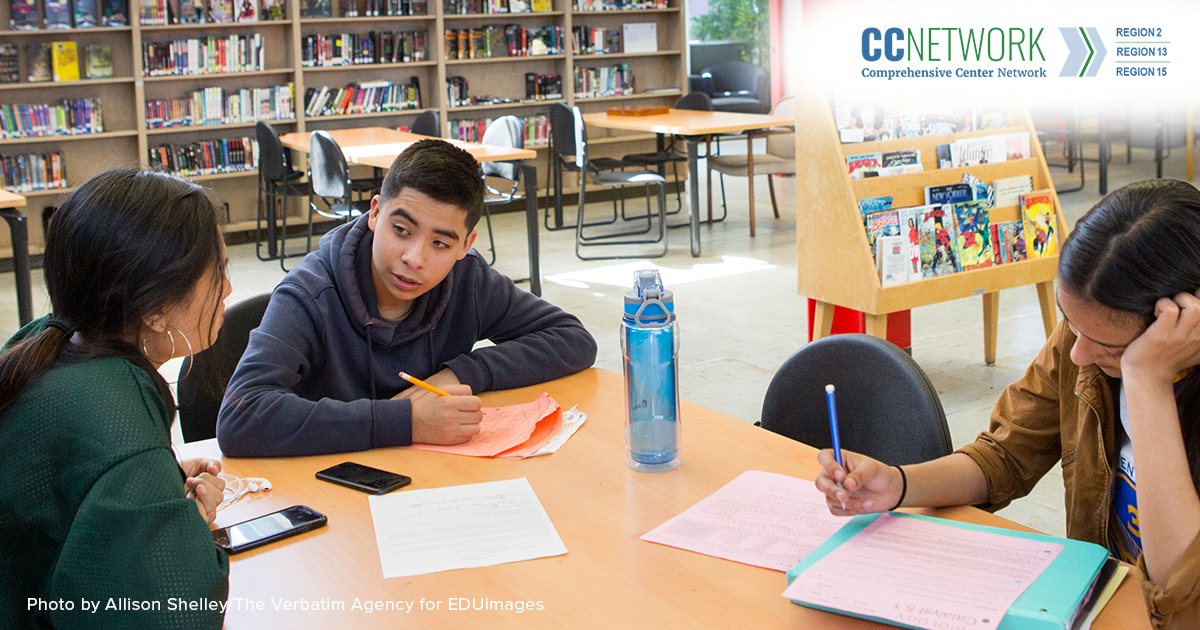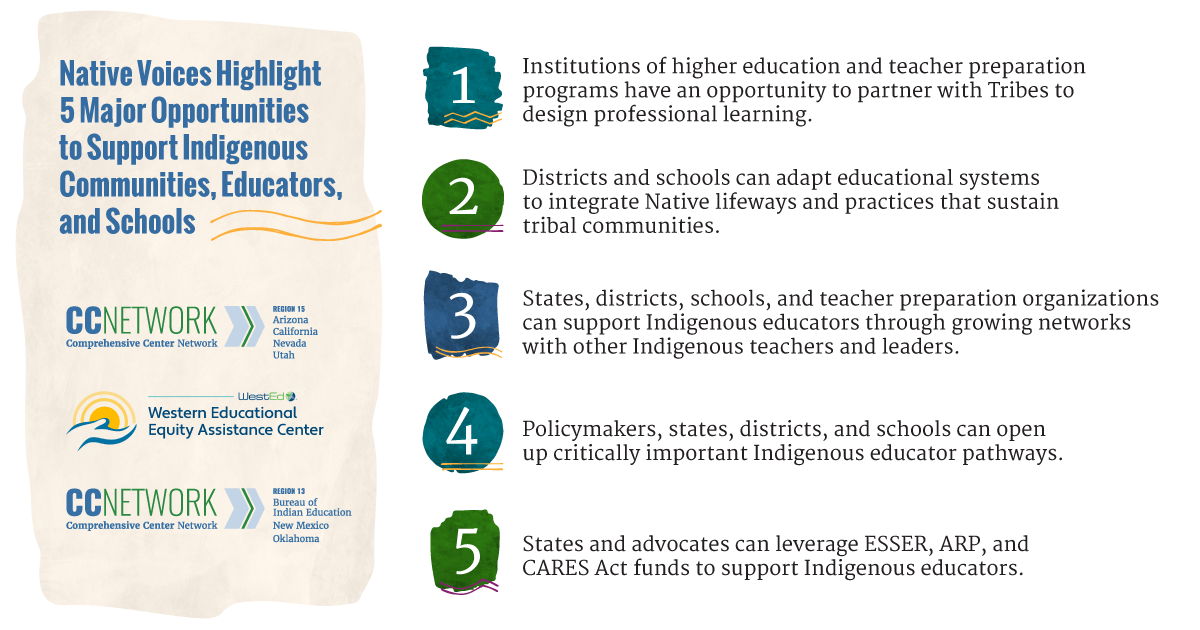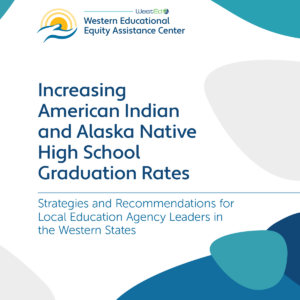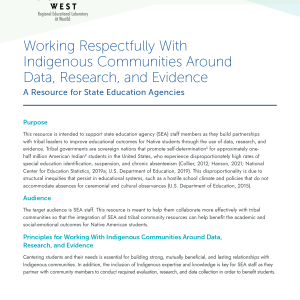Native Voices Highlight Five Major Opportunities to Support Indigenous Communities, Educators, and Schools
Posted on

Native leaders and practitioners serving Native students identified key opportunities for education organizations at all levels to open critically important pathways for Indigenous teachers and schools to serve as Native Nation builders. Five actionable thematic takeaways emerged.
Earlier this year, nearly 450 state and tribal leaders; education practitioners; Native language teachers; and traditional knowledge keepers representing 140 Tribal Nations, 35 states, 79 districts, and 24 state education agencies participated in a three-part webinar series, Making a Difference for American Indian and Alaska Native Students: Innovations and Wise Practices. Speakers and participants shared emerging and innovative examples of tribal educational sovereignty and nation building that center Indigenous peoples’ enduring legacy of teaching, learning, and leadership.
The goal of the series was to center Native voices that are amplifying systematic approaches with the potential to improve outcomes for American Indian and Alaska Native (AI/AN) students. Most important among these efforts are those supporting the recruitment, preparation, and retention of AI/AN educators—including establishing alternative licensure pathways.
Another focus was tribal efforts to promote tribal sovereignty and nation building through education. Tribal advocates shared the importance of legal, political, and spiritual foundations in designing and funding programs that nurture AI/AN students for school, college, career, and community life.
Six federally funded technical assistance centers presented the series, including Region 11, Region 13, Region 15, Region 16, and Region 17 Comprehensive Centers, in partnership with the Western Educational Equity Assistance Center and the Regional Educational Laboratories West, Northwest, Southwest, and Central.
The infographic shown below depicts five actionable thematic takeaways that emerged from a synthesis of conversations and presentations in the series.
Details on the series are accessible through the following:
- “Best Practices for Indigenous Educator Pathways”
- “Alternative Pathways for Indigenous Educators”
- “Tribal Advocacy for Educational Change”
- a live central resource hub, including access to the recorded webinars themselves, session archives, and related articles and research
A key takeaway from the series, shared by many Native speakers, is that centering Indigenous lifeways and values within education systems is a way to protect tribal sovereignty.
“As tribes nurture the next generation of Indigenous advocates, educators, researchers, and scholars to serve as tomorrow’s leaders, participants in the webinars emphasized how their cultural teachings, values, and beliefs continue to serve as powerful guiding forces in this work,” says Dr. Niki Sandoval (Santa Ynez Band of Chumash), Director of the Western Educational Equity Assistance Center (WEEAC) at WestEd.
Representatives from nearly 25 percent of federally recognized
Tribes participated in the series.
More than 95 percent of survey participants across the three webinars agreed that the session information was relevant and useful for their work.
 Institutions of higher education and teacher preparation programs have an opportunity to partner with Tribes to design professional learning.
Institutions of higher education and teacher preparation programs have an opportunity to partner with Tribes to design professional learning.
Prioritizing relationships and kinship is integral to designing educational programs. Use strategies that Native leaders identify as effective for gaining trust with tribal members, such as the following:
- starting with humility
- spending time with tribal representatives
- actively listening
- exhibiting commitment, responsiveness, and follow-through
- honoring/acknowledging knowledge
- identifying barriers
- being patient
- soliciting feedback
- investigating personal biases
- ethically stewarding data
Conduct and respond to extensive needs-sensing efforts to address socioemotional needs, such as feeling nurtured, recognized, and relevant, as well as any practical barriers to the success of Native teachers-in-training—like health insurance, housing, sufficient stipends, internet access, computers, exam options, training hurdles, and schedule flexibility.
Example: “Bringing everyone together in an organized way, a systematic way, scheduled way, really helped break down a lot of the barriers.” —Carrie Billy, (Navajo Nation), President and CEO of the American Indian Higher Education Consortium
For more, see “Best Practices for Indigenous Educator Pathways.”
 Districts and schools can adapt educational systems to integrate Native lifeways and practices that sustain tribal communities.
Districts and schools can adapt educational systems to integrate Native lifeways and practices that sustain tribal communities.
- Invite local Tribes and Indigenous educators to collectively indigenize student curricula, including developing place-based curricula and incorporating Indigenous history, culture, and language.
- Engage Elders throughout the educator training and induction processes.
- Incorporate spiritual and philosophical approaches such as connectedness and interdependence of all things and generosity of spirit.
- Use culturally sustaining Indigenous curricula in student learning and teacher preparation.
- Enable teachers to develop place-based school assignments.
- Align school schedules with Native cultural activities.
- Expand definitions of key concepts such as truancy, family, discipline, achievement, and learning in an effort to align with cultural values.
- Advance the availability of the Seal of Biliteracy for students who speak their Native languages.
Example: Doug Ruhman, Dean, Division of Education and Department Chair, Elementary Education of Salish Kootenai College, Montana, reported: “[W]e created a new series of courses which is called ‘integrative perspectives on science in education for educators’… built around the seasonal round of the Tribes here on the Flathead reservation. … There is a time for tanning hides and the chemistry and physics and all the various aspects, the scientific aspects, and the cultural practices associated with that are woven together. … That’s how we retain [future teachers]. … [It] is a recruitment tool to show how to generate excitement and innovation in your own classroom someday.”
For more, see “Best Practices for Indigenous Educator Pathways.”
 States, districts, schools, and teacher preparation organizations can support Indigenous educators through growing networks with other Indigenous teachers and leaders.
States, districts, schools, and teacher preparation organizations can support Indigenous educators through growing networks with other Indigenous teachers and leaders.
- Use cohort models for preservice preparation, induction, and ongoing professional learning.
- Encourage cohorts of Indigenous teachers to bring place, language, and culture into their work.
- Pair Indigenous educators with other Indigenous educators as mentors.
Example: The Blue Lake Rancheria Tribe situated in Northern California partnered with California State Polytechnic in Humboldt, local county offices of education, school districts, and Native Nations in the region to develop a “Grow Your Own Administrator” (GYOA) prospective-leader cohort program. According to new principal Margaret Peters (Ner-er-ner/Puhliklah [Yurok] and Karuk), a GYOA participant, “we grew a sense of family. … I think that when you take this step, with multiple people, who are all participating in a program together, we definitely felt empowered. I felt empowered because we were occupying a space as a cohort within a larger cohort, and Native voices were really elevated.”
For more, see “Alternative Pathways for Indigenous Educators.”
 Policymakers, states, districts, and schools can open up critically important Indigenous educator pathways.
Policymakers, states, districts, and schools can open up critically important Indigenous educator pathways.
- Create early “teacher” exposure pathways, through such means as inviting Indigenous middle school students to begin supporting other students in younger classrooms and providing high school students the chance to take early childhood development courses and get hands-on internship experience in early childhood education classrooms.
- Offer dual enrollment to Indigenous educators (e.g., through partnerships between districts and local community colleges).
- Create alternative licensure and certification pathways for Indigenous culture bearers and language teachers, and ensure parity in compensation for those teachers.
- Provide greater access and opportunity for Indigenous language and culture teachers to engage in general education teacher preparation, and expand alternative certificates to learn skills like lesson planning and classroom management.
Example: Joel Isaak (Dena’ina), Tribal Affairs Director for Alaska’s Department of Education and Early Development, noted that “you need to start really early and make that strong connection with the youth to guide them on those pathways. … Our turnover rate for local people who live in the communities is much lower.” In Alaska, he noted the need to overcome programmatic barriers for Native language teachers in particular. “What was happening was, if you are speaking in your target language and there’s no Praxis exam in your target language and you have to have a Praxis to become certified for pay equity, then you functionally can’t have an immersion program with licensed teachers that speak that language.”
For more, see “Alternative Pathways for Indigenous Educators.”
 States and advocates can leverage ESSER, ARP, and CARES Act funds to support Indigenous educators.
States and advocates can leverage ESSER, ARP, and CARES Act funds to support Indigenous educators.
- Ask about flexibility in available funds and different ways to use them. Identifying federal and state funding streams that can be granted directly to Tribes supports tribal sovereignty and autonomy.
- Base Indigenous recruitment and retention efforts on relevant state and school data to focus on funding Indigenous educator pathway efforts where they are most needed.
- Create structures to elicit recommendations from a wide range of tribal leaders and community members when allocating funding streams.
Example: Regis Pecos, former governor of Cochiti Pueblo and co-founder of the Indigenous think tank, Leadership Institute, explained the statewide engagement process he spearheaded with tribal nations in New Mexico. Pecos and his team traveled from tribal community to community to secure tribal resolutions from 23 sovereign nations as part of providing input into, and formally endorsing, the new Tribal Remedy Framework.
The Framework, a comprehensive plan to meet the educational needs of Native students and their tribal communities, elevates the role of tribal education departments, develops community-based educational systems, and promotes culturally and linguistically relevant education. “It was an incredible engagement of people at multiple levels in our communities. …. . . It is really an unprecedented unification of all 23 Tribal nations,” said Pecos.



